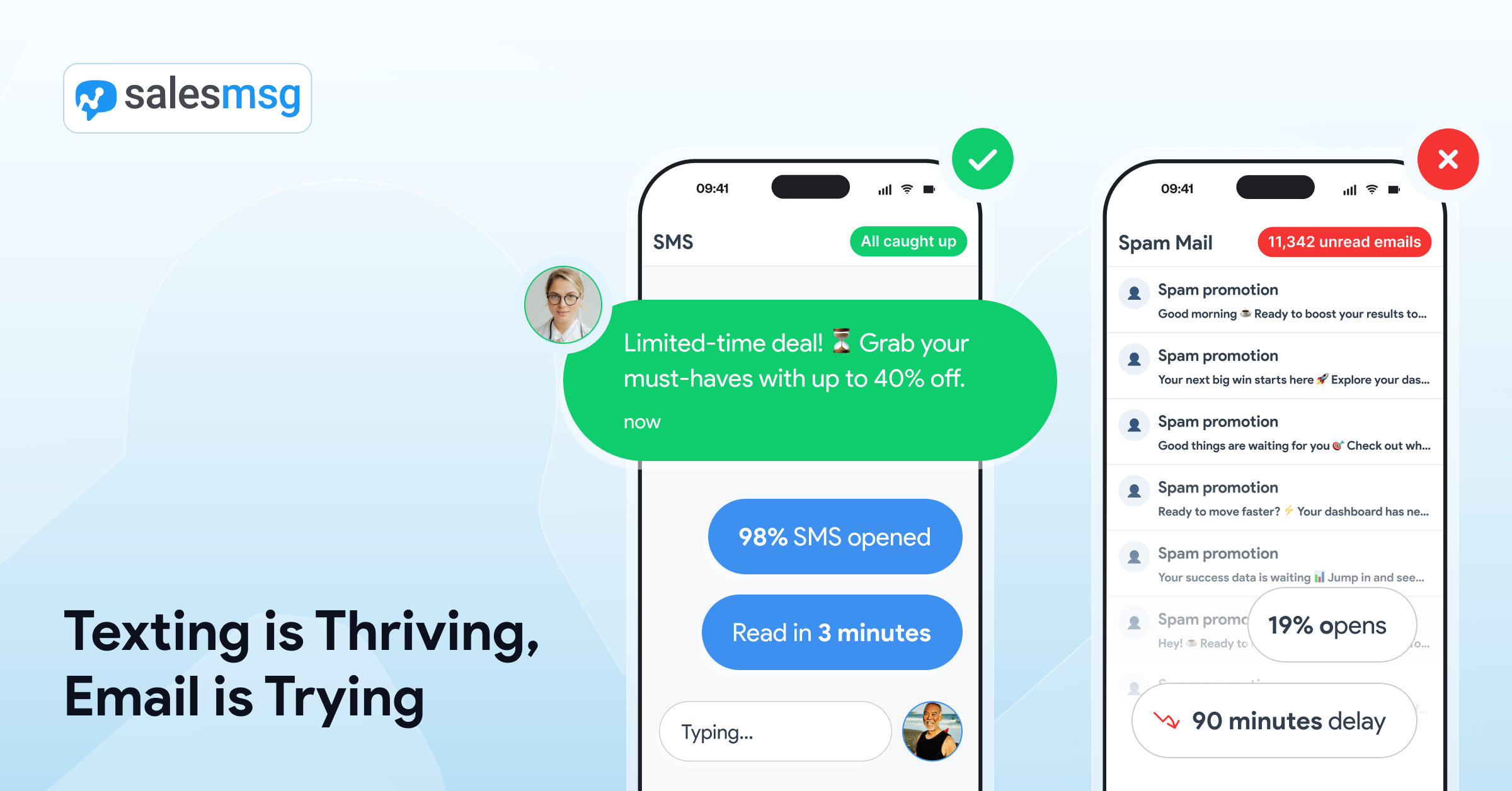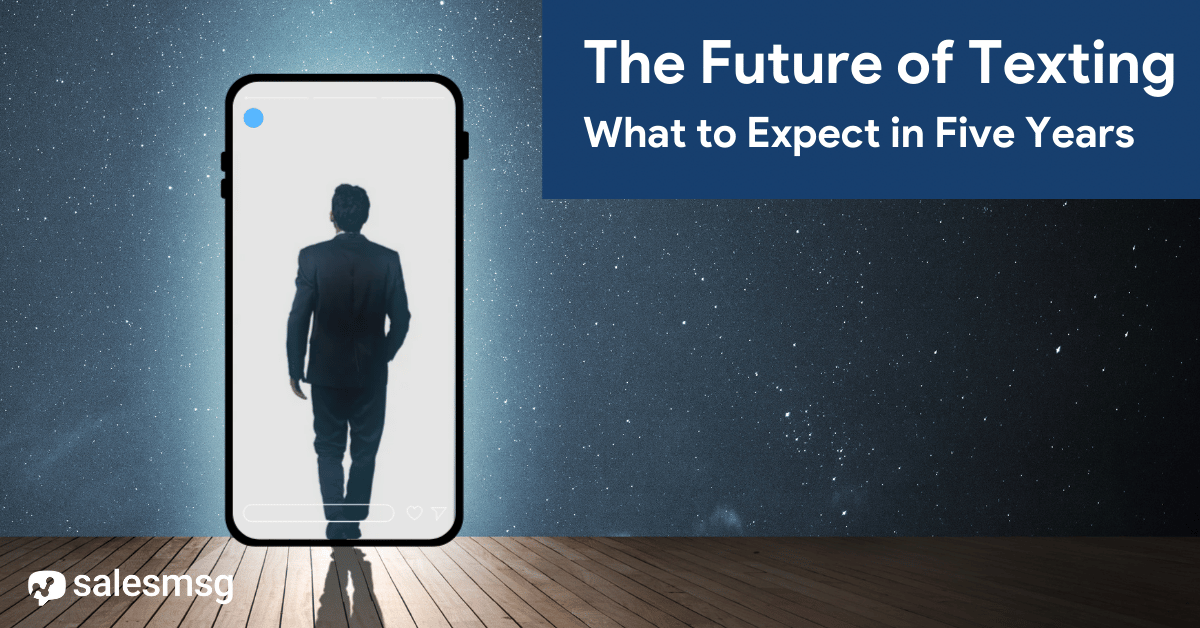7 Best Texts to Reach Students with HubSpot and Salesmsg

Quick Summary
Texting is the fastest way to reach students—period. This guide shows you how universities use texting to boost enrollment, reduce no-shows, and improve the student experience with SMS messages.
-----------------------------
Gen Z spends over six hours a day on their phones and sends over 50 texts a day on average.
If you want to communicate with new and existing students, you need to meet them where they are—on their phones.
Knowing how to leverage text messages to communicate with students opens up the most effective channel for communication (and makes your university, college, trade school or even personal coaching program stand out).
By adding texting, you can communicate more easily with students, improve their experience, and streamline aspects of the application, registration, and even payment process.
In this guide, we’ll explore how your university, college or other school can use SMS messages to improve communication, streamline the enrollment process, and enhance the experience for both students and parents. You’ll also find seven high-impact text examples you can start using today.

5 use cases for sending SMS messages to your students
Texting opens up a range of different possibilities for communicating with your students. Here are five different ways you can use SMS messages to get your students’ attention.
Boost enrollment with time-sensitive messages
Text messages are very effective at sending important reminder messages, like enrollment deadlines. The average student applies to six schools at once. That means it’s easy for students to lose track of application deadlines.
SMS lets you send simple text messages to your prospective students to help keep them on track. You can send messages that link directly to the application form so they can pick up where they left off.
Improve event attendance with reminder text messages
Campus tours. Open houses. Family days. Virtual tours.
You’re likely creating multiple events just to attract potential students to your school. But how are you encouraging would-be students to actually attend?
90% of text messages are read within minutes. That makes SMS the best channel for reaching students (and their parents) and getting them to show up for events like this.
With email, it's easy for messages to get buried and important dates to pass by. Text messages are really the only way to communicate this sense of urgency in real time—and expect a response.

Send timely reminder messages for deadlines and payments
Course registration. Tuition payments. Financial Aid assistance.
There are all kinds of important academic deadlines to remember. SMS makes it easy to communicate these deadlines, helps students avoid missing important dates, and reduces stress for students.
Deadline text messages can also be sent about scholarship applications, finals and other important dates too.
Keep students engaged with regular follow-ups
You can use follow-up SMS messages to connect with your students from the second they decide to apply for your university—to the moment they graduate.
For example, let’s say a new potential student fills out your web form on your website. You could do the traditional reach-out to that student. (Send them direct mail, shoot them emails, perhaps even call.) Or you could reply automatically with a text message they're almost guaranteed to see.
If you have permission to text that new applicant, you can respond with an automatic text message. Then you can send a series of follow-up texts to help move them through the process of showing interest, all the way to submitting an application.

Offer additional campus service-related SMS messages
Depending on how you want to integrate SMS into your student communication, you also have the option of adding text messages to different departments.
For example, with admissions, you can use SMS to answer enrollment-related questions. For the registrar, you can have a text message sequence that confirms students have submitted the proper documents. For general student life, you can use texts to keep students informed about all campus events.
7 best texts to send students with Salesmsg and HubSpot
Now that you understand the different ways SMS messages can be used, let's look at a few different text message samples that you can send to your students today:
1. Class Schedule Reminder
Texting can be an easy way for teachers to communicate with students about class updates or schedule changes.
Here’s an example message you can send:
- “Hi [Name], don't forget your [Course Name] class tomorrow at [Time] in the [Name] building. Click here for details: [Link]."

2. Application Deadline Alerts
Enrollment and admission offices can improve enrollment numbers by reaching students about important deadlines.
Here’s a sample message you can send:
- "Hi [Name], the deadline to submit your application is [Date]. Don't miss out—apply here: [Link]."
3. Event Invitations
Whether you’re managing campus tours, open campus events, family days, or webinars for interested students, being able to reach out to students in a timely manner is the difference between a booked event or endless no shows.
Here’s a sample text to improve event attendance:
- "Hi [Name], join us for the [Event Name] on [Date]! Get details/RSVP here: [Link]."

4. Payment Reminders
Tuition deadlines can sneak up on students and parents—especially during busy academic periods. Sending timely payment reminders helps avoid late fees, reduce confusion, and keep financial records on track.
Here’s a practical text you can send:
- "Reminder: Your tuition payment for [Term] is due on [Date]. Pay here: [Link]."
5. Enrollment Confirmations
The moment a student is officially enrolled is a big deal—so make it feel like one. A confirmation text is a great way to celebrate the milestone and guide them to their next step, like accessing the student portal or scheduling orientation.
Here’s a welcoming message to send:
- "Welcome, [Name]! You're officially enrolled in [Program Name]. Click here to access your student portal: [Link]."

6. Event Follow-Ups
After a campus tour, open house, or webinar, students are often at their highest point of interest. Following up right after the event helps keep the momentum going—while the experience is still fresh.
Here’s a sample follow-up text:
- "Thanks for attending [Event Name]! Here's a recording and resources to help you: [Link]."
Pro tip: With Salesmsg, you can also use text-to-join keywords at live events to quickly grow your texting list and stay in touch with engaged students.
Example: “Text JOINUCLA to XXX-XXX to get campus tour updates and admissions deadlines sent straight to your phone.”
7. Crisis Communication
When urgent situations arise, such as weather-related closures, safety alerts, or emergency announcements, texting is the fastest and most reliable way to reach your students instantly.
Here’s a sample message you can send for campus closures:
- "URGENT: Due to [Reason], all classes are canceled on [Date]. Check your email for more info."

3 benefits of SMS for higher education
SMS is one of the simplest and most effective ways to reach your students.
SMS is a versatile tool, whether you're trying to boost enrollment, communicate upcoming deadlines, support faculty and student communication, or improve event attendance. It offers direct customer engagement that you can’t get from other channels.
Here are some of the core reasons SMS is so valuable for higher ed:
1. SMS Messages Get Read—Fast
Most text messages are read within minutes of being received.
That makes SMS ideal for time-sensitive updates like scholarship deadlines, class schedule changes, or last-minute event details.
Compared to email or phone calls, texting offers a reliable way to ensure your message actually reaches the student when it matters most.
2. Personalized communication at scale
SMS makes it easy to send personalized, one-to-one messages—without sacrificing efficiency.
With a SMS tool like Salesmsg, you can automatically personalize texts using student data from your CRM, such as name, program of interest, enrollment status, or event attendance.
This helps your text messages feel more relevant, increases engagement, and builds stronger relationships with students from day one.
3. Instant results and tracking
With SMS, you don’t have to wait and wonder if your messages worked or not. You can track responses, link clicks, and reply volume in real time.
Salesmsg gives you access to detailed reporting and analytics so you can quickly evaluate what’s working—and improve your outreach with data-driven decisions. You’ll be able to see click tracking data, conversions, number of replies, and much more.
3 best practices for higher education SMS campaigns
Beyond the different types of campaigns you can create, there are a few best practices to keep in mind to help you create high-converting messages to help you reach your goals.
Send messages during the right time of day
Just because students are on their phones all day doesn’t mean they want texts at all hours. Timing matters—your goal is to send text messages when students are most likely to read and respond.
One simple way to do this is by adding SMS to your existing automated email campaigns. For example, if you have a HubSpot workflow that triggers when a student fills out a form, you can add a Salesmsg text to follow up instantly.
Inside Salesmsg, you can set designated Business Hours so messages are only sent during appropriate times—such as standard academic hours—ensuring your texts reach students when they’re most likely to engage.

Keep your messages concise and clear
Your texts should be short, easy to digest, and focused on just one message.
Students—especially Gen Z—are busy, juggling classes, work, and notifications from multiple apps. They have limited time and short attention spans, so clarity and brevity are key.
We recommend keeping messages around 160 characters whenever possible. That said, Salesmsg does allow you to send longer messages if needed.
Think about when you get a text from a friend. It’s usually short, to the point, and focused on a single idea. Your student messages should follow the same format to get the best response.
Get set up for compliance first
Before you start texting students, there’s one important thing to know—you need to register with mobile carriers first. This is called 10DLC A2P compliance, and it’s required for any school or organization sending business texts from a 10-digit phone number.
The good news? Salesmsg builds this right into the setup process.
You’ll get step-by-step guidance and compliance tools to complete everything you need—without the hassle. That way, you can start texting with confidence, knowing your school is fully approved and in line with carrier rules.
How to use Salesmsg to boost results
To get the most out of SMS, you need a platform that’s built for scale, automation, and easy integration with your CRM—like HubSpot.
Salesmsg checks all those boxes. Whether you’re starting with admissions outreach or expanding SMS across your entire campus, Salesmsg makes it easy to manage text messaging for multiple departments from a single account.
You can create bulk campaigns, automated drip sequences, and real-time follow-ups—all directly inside Salesmsg or through your existing HubSpot workflows. And because everything is synced, you can text directly from your HubSpot dashboard or inside Salesmsg itself.
Best of all, you’ll get access to detailed reporting so you can track results, measure performance, and keep improving your outreach over time.
Conclusion: Higher education demands higher communication
As you’ve seen, SMS messages can be a valuable tool for higher education institutions.
SMS can help school staff, admissions, and enrollment offices, and build relationships with prospective students across outreach, recruitment, and SMS marketing.
Salesmsg makes it easy to implement SMS across your entire institution and every department. If you’re already using the HubSpot CRM, then adding Salesmsg and sending text messages is only a couple clicks away.
Ready to transform student engagement with SMS? Start a 14-day free trial of Salesmsg and experience the power of SMS firsthand.

Frequently Asked Questions
What types of messages can universities send via SMS?
Universities can use SMS for a wide range of messages—from enrollment and application updates to registration reminders, event invitations, follow-ups, and more. Texting is especially effective for time-sensitive updates and keeping students engaged throughout the academic journey.
Can I use SMS for both prospective and current students?
Absolutely. SMS is great for reaching prospective students during the admissions process and just as effective for keeping current students informed about deadlines, events, campus updates, and more.
How do I integrate SMS with HubSpot for higher education?
The easiest way is to use the Salesmsg + HubSpot integration. In just a few clicks, you can add two-way texting capabilities to your HubSpot workflows—ideal for admissions, advising, alumni outreach, and more.
Are there compliance considerations for sending SMS to students?
Yes. To text students using a 10-digit phone number, your institution must register for 10DLC A2P compliance—a process required by U.S. mobile carriers. You also need to obtain proper consent (opt-in) and provide easy opt-out options. Salesmsg has built-in tools to guide you through compliance, so you can text with confidence.
How can I learn more about using Salesmsg for higher education?
You can start a free 14-day trial to see how Salesmsg works with your student communication workflows. Or, if you’d prefer a walkthrough, schedule a quick demo with our team to see how universities are using texting to improve engagement, retention, and response across every department—from admissions to student life.




















